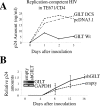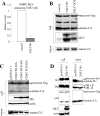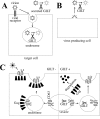Gamma-interferon-inducible, lysosome/endosome-localized thiolreductase, GILT, has anti-retroviral activity and its expression is counteracted by HIV-1
- PMID: 27655726
- PMCID: PMC5342076
- DOI: 10.18632/oncotarget.12104
Gamma-interferon-inducible, lysosome/endosome-localized thiolreductase, GILT, has anti-retroviral activity and its expression is counteracted by HIV-1
Abstract
The mechanism by which type II interferon (IFN) inhibits virus replications remains to be identified. Murine leukemia virus (MLV) replication was significantly restricted by γ-IFN, but not human immunodeficiency virus type 1 (HIV-1) replication. Because MLV enters host cells via endosomes, we speculated that certain cellular factors among γ-IFN-induced, endosome-localized proteins inhibit MLV replication. We found that γ-IFN-inducible lysosomal thiolreductase (GILT) significantly restricts HIV-1 replication as well as MLV replication by its thiolreductase activity. GILT silencing enhanced replication-defective HIV-1 vector infection and virion production in γ-IFN-treated cells, although γ-IFN did not inhibit HIV-1 replication. This result showed that GILT is required for the anti-viral activity of γ-IFN. Interestingly, GILT protein level was increased by γ-IFN in uninfected cells and env-deleted HIV-1-infected cells, but not in full-length HIV-1-infected cells. γ-IFN-induced transcription from the γ-IFN-activation sequence was attenuated by the HIV-1 Env protein. These results suggested that the γ-IFN cannot restrict HIV-1 replication due to the inhibition of γ-IFN signaling by HIV-1 Env. Finally, we found that 4,4'-dithiodipyridine (4-PDS), which inhibits S-S bond formation at acidic pH, significantly suppresses HIV-1 vector infection and virion production, like GILT. In conclusion, this study showed that GILT functions as a host restriction factor against the retroviruses, and a GILT mimic, 4-PDS, is the leading compound for the development of novel concept of anti-viral agents.
Keywords: antiviral; endosome; gamma-interferon; retroviruses; thiolreductase.
Conflict of interest statement
There is no conflict of interest.
Figures












Similar articles
-
IDO1, FAT10, IFI6, and GILT Are Involved in the Antiretroviral Activity of γ-Interferon and IDO1 Restricts Retrovirus Infection by Autophagy Enhancement.Cells. 2022 Jul 19;11(14):2240. doi: 10.3390/cells11142240. Cells. 2022. PMID: 35883685 Free PMC article.
-
Antivirus activity, but not thiolreductase activity, is conserved in interferon-gamma-inducible GILT protein in arthropod.Mol Immunol. 2021 Dec;140:240-249. doi: 10.1016/j.molimm.2021.10.018. Epub 2021 Nov 10. Mol Immunol. 2021. PMID: 34773863
-
IFITM3 Reduces Retroviral Envelope Abundance and Function and Is Counteracted by glycoGag.mBio. 2020 Jan 21;11(1):e03088-19. doi: 10.1128/mBio.03088-19. mBio. 2020. PMID: 31964738 Free PMC article.
-
Disulfide reduction in the endocytic pathway: immunological functions of gamma-interferon-inducible lysosomal thiol reductase.Antioxid Redox Signal. 2011 Aug 1;15(3):657-68. doi: 10.1089/ars.2010.3684. Epub 2011 Apr 20. Antioxid Redox Signal. 2011. PMID: 21506690 Free PMC article. Review.
-
[In vitro and in vivo inhibition of HIV1 replication by retroviral transfer of interferon alpha, beta, or gamma genes: application to gene therapy of AIDS].Ann Biol Clin (Paris). 1998 Mar-Apr;56(2):167-73. Ann Biol Clin (Paris). 1998. PMID: 9754242 Review. French.
Cited by
-
Direct Antiviral Mechanisms of Interferon-Gamma.Immune Netw. 2018 Oct 17;18(5):e33. doi: 10.4110/in.2018.18.e33. eCollection 2018 Oct. Immune Netw. 2018. PMID: 30402328 Free PMC article. Review.
-
Unique Mode of Antiviral Action of a Marine Alkaloid against Ebola Virus and SARS-CoV-2.Viruses. 2022 Apr 15;14(4):816. doi: 10.3390/v14040816. Viruses. 2022. PMID: 35458549 Free PMC article.
-
Multiple Inhibitory Factors Act in the Late Phase of HIV-1 Replication: a Systematic Review of the Literature.Microbiol Mol Biol Rev. 2018 Jan 10;82(1):e00051-17. doi: 10.1128/MMBR.00051-17. Print 2018 Mar. Microbiol Mol Biol Rev. 2018. PMID: 29321222 Free PMC article. Review.
-
Medroxyprogesterone Acetate (MPA) Enhances HIV-1 Accumulation and Release in Primary Cervical Epithelial Cells by Inhibiting Lysosomal Activity.Pathogens. 2021 Sep 14;10(9):1192. doi: 10.3390/pathogens10091192. Pathogens. 2021. PMID: 34578224 Free PMC article.
-
Rab3a-Bound CD63 Is Degraded and Rab3a-Free CD63 Is Incorporated into HIV-1 Particles.Front Microbiol. 2017 Aug 29;8:1653. doi: 10.3389/fmicb.2017.01653. eCollection 2017. Front Microbiol. 2017. PMID: 28900422 Free PMC article.
References
-
- Sheehy AM, Gaddis NC, Choi JD, Malim MH. Isolation of a human gene that inhibits HIV-1 infection and is suppressed by the viral Vif protein. Nature. 2002;418:646–650. - PubMed
-
- Neil SJ, Zang T, Bieniasz PD. Tetherin inhibits retrovirus release and is antagonized by HIV-1 Vpu. Nature. 2008;451:425–430. - PubMed
-
- Krapp C, Hotter D, Gawanbacht A, McLaren PJ, Kluge SF, Stuzel CM, Mack K, Reith E, Engelhart S, Ciuffi A, Hornung V, Sauter D, Teleni A, Kirchhoff F. Guanylate binding protein (GBP) 5 is an interferon-inducible inhibitor of HIV-1 infectivity. Cell Host Microbe. 2016;19:504–514. - PubMed
MeSH terms
Substances
LinkOut - more resources
Full Text Sources
Other Literature Sources
Miscellaneous

